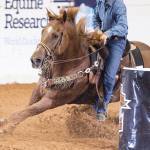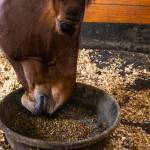Horses in Motion: Countering Locomotive Stress

Have you ever stopped to think about what a horse’s body endures while in motion? Moreover, do you ever contemplate what more you could do to support your horse’s bones and joints?
According to a recent study*, the body of a quadrupedal, or four-legged, animal such as a horse can be likened to a heavy beam (the spinal column) with two supports at each end (sets of limbs). When at rest, strong connective tissues support the beam. Examples include the fascia or outer covering of the abdominal muscles as well as ligaments and tendons between bones and muscles. Skeletal structures, such as the sternum and ribs, also play a supporting role.
During locomotion, skeletal muscles help counteract the external forces the beam experiences. Help from skeletal musculature must occur in order for the horse’s body to maintain its shape while simultaneously moving comfortably and efficiently.
Consider the following:
- Under a horse’s own massive body weight, the spinal column is subjected to shearing, bending, and compressive stresses. The trunk naturally attempts to sag downwards, which is opposed by muscles and connective tissues.
- During locomotion, the mass of the body accelerates upward. At the trot or canter, accelerations double, meaning the horse feels like its body weight doubles compared to when it is at rest.
- Add the fact that this now doubly heavy trunk doesn’t always have four supports. Depending on the gait, there may only be one limb on the ground to support the body mass.
- In other situations, such as galloping or jumping, there are no contacts with the ground, and the body floats freely through the air. As we know, what goes up must come down. When this happens, the forces experienced by the beam can be impressive and must be countered by muscles, bones, and connective tissues.
“While joints and joint disease often receive the most attention when considering locomotion, clearly muscles, bones, and soft tissue structures also suffer substantial wear and tear, even during light work involving walk, trot, and canter on the flat,” noted Kathleen Crandell, Ph.D., a nutritionist for Kentucky Equine Research (KER).
Recognizing the importance of joint health for maximizing equine athleticism and longevity, Kentucky Equine Research formulated an array of joint supplements, such as KER-Flex, with chondroitin sulfate and glucosamine hydrochloride, Synovate HA with high molecular weight hyaluronic acid, and EO-3, a marine-derived source of DHA and EPA, both of which are omega-3 fatty acids.
“Kentucky Equine Research also offers DuraPlex to support healthy bones and improve and maintain bone quality. This product contains vitamins, minerals, and protein to benefit horses in training and competition, as well as convalescent athletic horses to minimize loss of bone mineral density,” Crandell explained.
Also from Kentucky Equine Research, Triacton is a triple-action pelleted supplement designed to improve bone density while simultaneously supporting stomach and hindgut health in horses. Triacton features a highly digestible source of calcium, and studies have demonstrated the positive effects of Triacton on bone density.
In addition to Triacton, Australian horse owners should look for Glucos-A-Flex, Synovate HA and Bone Food Plus.
*Kienapfel, K., H. Preuschoft, A. Wulf, et al. 2018. The biomechanical construction of the horse’s body and activity patterns of three important muscles of the trunk in the walk, trot and canter. Journal of Animal Physiology and Animal Nutrition (Berl) 102(2):e818-e827.








